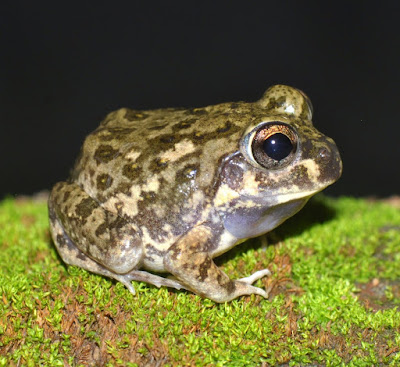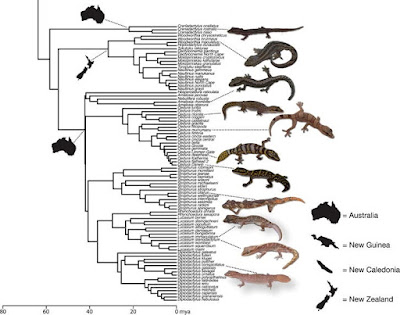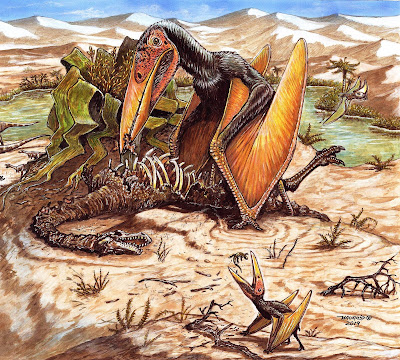[Most Recent Entries] [Calendar View]
Wednesday, August 21st, 2019
| Time | Event | ||||
| 6:09a | [Herpetology • 2019] Sphaerotheca magadha • A New Species of Sphaerotheca Gunther, 1859 (Anura: Dicroglossidae) from the Agro Ecosystems of Chota Nagpur Plateau, India
Abstract Members of the genus Sphaerotheca are known to have the distribution in the low to mid elevation landscapes of South Asia. Most of the descriptions are either from homestead areas or from agro ecosystems except for a couple of species described from the mid elevated forest areas. The taxonomic uncertainties prevalent in the group was attended very recently, limiting the descriptions of five species to India, two species to Nepal and one each to Pakistan and Sri Lanka (one undescribed species from Myanmar). Here a new species assignable to the morphological 'Breviceps group' is described from the agro ecosystems of Jharkhand based on a combination of morphological, phylogenetic and geographical studies using integrated taxonomic approach. Besides, the distribution status of Sphaerotheca pashchima is discussed and the possibility of a new species occurring in Myanmar is pointed out. Keywords: Agro Ecosystem, Jharkhand, New Species, Plateau, Sphaerotheca.
Sphaerotheca magadha sp. nov. Field Diagnosis: Morphology: In the field, Sphaerotheca magadha sp. nov. does not have any morphologically similar congeneric sympatric species, and it can be easily identified on the basis of the combination of morphological characters like medium size, stumpy and squat body, wider head width than head length, rounded snout, angled canthus rostralis, first finger longer than the second (and sub equal to third finger), short hind limbs which do not touch when folded at right angles to the body, tibiotarsal articulation reaching front of shoulders, moderate webbing, distinct shovel shaped inner metatarsal tubercle and a prominent tarsal tubercle. For comparisons of the new species Sphaerotheca magadha sp. nov. with its phylogenetic sister species Sphaerotheca breviceps and its congeners, see section below. Geography: This species is known from low to mid elevation (380 m) agricultural lands of semi urbanized Nawadih village, Jharkhand (Figure 5). This species is geographically 1600 km away (aerial distance) from the type locality of the phylogenetic sister species S. breviceps and 1800 km away (aerial distance) from the type locality of the morphologically similar species S. rolandae. Additional sampling and genetic studies are required to establish the range limits of the phylogenetic sister (S. breviceps) and the morphologically similar species (S. rolandae). Etymology The specific epithet is derived from the term ‘Magadha’, an ancient kingdom located on the Indo-Gangetic plains in the eastern Indian state Jharkhand. Suggested common name: ‘Magadha burrowing frog’ species epithet is treated as noun in apposition to generic name. Distribution and Natural history Sphaerotheca magadha sp. nov. is known specifically from Joungi and Nawadih village of Koderma district of Jharkhand in Chota Nagpur Plateau. Chota Nagpur Plateau is having geological significance in terms of the continental drift theory (Mani, 1974; Ghosh et al., 2015). We found this species to be common locally on the road side muddy puddles and it was observed calling and breeding during pre-monsoon showers of June. Vishal Kumar Prasad, K. P. Dines, Abhijit Das , Priyanka Swamy, Ajinkya D. Shinde and Jadhav Bapurao Vishnu. 2019. A New Species of Sphaerotheca Gunther, 1859 (Amphibia: Anura: Dicroglossidae) from the Agro Ecosystems of Chota Nagpur Plateau, India. Rec. Zool. Surv. India. 119(3); 197-210. DOI: 10.26515/rzsi/v119/i3/2019/132173 RecordsofZsi.com/index.php/zsoi/article/v New burrowing frog species discovered punemirror.indiatimes.com/pune/civic/new-b | ||||
| 8:30a | [Herpetology • 2019] Relicts and Radiations: of An Australasian Lizard Clade (Gekkota: Diplodactyloidea) with east Gondwanan Origins
Highlights: • Ultraconserved elements resolve nearly all problematic relationships of diplodactyloid geckos. • Phylogenenomic estimates differs greatly from Sanger estimates at species-level rather than reaffirms previously proposed relationships. • Molecular dating confirms young crown ages of New Caledonian and New Zealand diplodactylids relative to mainland Australian radiations. • No mass extinction event associated with Eocene-Oligocene cooling detected. • Tail moprhology suggests that the environment has influenced tail shape extensively. Abstract Australasia harbors very high squamate diversity and is a center of endemicity for a number of major lineages. However, despite this diversity, the diplodactyloid geckos of Australia, New Caledonia, and New Zealand (comprised of three endemic families and > 200 species) are the only extant squamates with unequivocal Mesozoic origins in the region. Diplodactyloid geckos also exhibit notable phenotypic and ecological diversity, most strikingly illustrated by the functionally limbless pygopods. Here, we present the first phylogenomic analyses of the pattern and timing of diplodactyloid evolution, based on a dataset of more than 4,000 ultraconserved elements (UCEs) from 180 species. These analyses fully resolve nearly all nodes, including a number of intergeneric relationships that have proven problematic in previous studies. The hypothesis that New Caledonia and New Zealand clades represent independent post-KT boundary colonization events of Tasmantis from Australian ancestors is confirmed. Phylogenetic relationships recovered here further highlight contrasting patterns of diversity, most strikingly between insular and/or morphologically highly derived clades that have diversified rapidly, as opposed to other species poor and phylogenetically divergent relictual lineages on mainland Australia. Our new timetree suggests slightly older branching times than previous analyses and does not find a mass extinction event in the early Cenozoic. Finally, our new phylogeny highlights caudal variation across the clade. Most strikingly, the distinctive leaf-tail morphology shown by one family may in fact be plesiomorphic. Conclusion: This study represents the first phylogenomic attempt to address the higher-level relationships of an Australasian group of squamates. Our findings resolve many problematic relationships for a biogeographically unique and ecomorphologically diverse lineage. In so doing they highlight both remarkable phylogenetic relicts and instances of marked and potentially convergent ecomorphological evolution. Our study highlights the power of implementing genome-scale data to address questions in macroevolution, and the need for similar frameworks for other diverse and highly endemic Australasian radiations. Phillip L. Skipwith, Ke Bi and Paul M. Oliver. 2019. Relicts and Radiations: of An Australasian Lizard Clade with east Gondwanan Origins (Gekkota: Diplodactyloidea). Molecular Phylogenetics and Evolution. In Press. DOI: 10.1016/j.ympev.2019.106589 | ||||
| 9:37a | [Paleontology • 2019] Keresdrakon vilsoni • A New Toothless Pterosaur (Pterodactyloidea) from Southern Brazil with Insights Into the Paleoecology of A Cretaceous Desert
ABSTRACT The first pterosaur bone bed from Brazil was reported in 2014 at the outskirts of the town Cruzeiro do Oeste, Paraná State, in the Southern region of the country. Here named 'cemitério dos pterossauros' site, these outcrops were referred to the Goio-Erê Formation (Turonian-Campanian) of the Caiuá Group (Bauru Basin) and revealed the presence of hundreds of isolated or partially articulated elements of the tapejarine pterosaur Caiuajara and fewer amounts of a theropod dinosaur. Here we present a new tapejaromorph flying reptile from this site, Keresdrakon vilsoni gen. et sp. nov., which shows a unique blunt ridge on the dorsal surface of the posterior end of the dentary. Morphological and osteohistological features indicate that all recovered individuals represent late juveniles or sub-adults. This site shows the first direct evidence of sympatry in Pterosauria. The two distinct flying reptiles coexisted with a theropod dinosaur, providing a rare glimpse of a paleobiological community from a Cretaceous desert. Key words: Paleoecology; Pterosauria; Pterodactyloidea; Keresdrakon vilsoni; Paraná; Cretaceous SYSTEMATIC PALEONTOLOGY PTEROSAURIA Kaup 1834 PTERODACTYLOIDEA Plieninger 1901 AZHDARCHOIDEA Nesov 1984 TAPEJAROMORHA Andres et al. 2014 Keresdrakon gen. nov. Etymology: A combination of Keres, death-spirits who personified violent death in Greek mythology and are associated to doom and/or plunder; and drakon, which is the Ancient Greek word for dragon or huge serpent. Type species: Keresdrakon vilsoni, type by monotypy. Keresdrakon vilsoni gen. et sp. nov. Etymology. In honor to Mr. Vilson Greinert, a volunteer who dedicated hundreds of hours preparing most of the specimens from 'cemitério dos pterossauros' site housed in CENPALEO and in the town of Cruzeiro do Oeste. Type locality, horizon and age. 'cemitério dos pterossauros' site (53° 03′ 53,4″W; 23° 45′ 34,5″S - contra Langer et al. 2019), Cruzeiro do Oeste, Paraná State, Brazil; Bauru Basin, Caiuá Group, Goio-Erê Formation Cretaceous (Milani et al. 2007, Basilici et al. 2012, Batezelli 2015). Diagnosis. Azhdarchoid pterodactyloid with the following autapomorphies: short blunt ridge on the dorsal surface of the posterior end of the dentary; foramen on the ventral surface at the anterior half of the proximal articulation of the first phalanx of digit IV; and foramen on lateral surface of the ischium. The new species can be further distinguished from other azhdarchoid pterosaurs by the following combination of characters: dorsal margin of the premaxillae above the nasoantorbital fenestra rounded; sagittal groove on the dorsal surface of the premaxillae above the nasoantorbital fenestra; ridge on the medial surface of the splenial; ventral bar of the nasoantorbital fenestra thick; lateral pneumatic foramen on mid-cervical vertebra large; and strongly asymmetrical sternal articulation of the coracoid.
CONCLUSIONS: The coexistence of fossil vertebrates, including pterosaurs, are hard to be proven in the fossil record, specially cases of sympatry. Regarding pterosaurs, there must have been several places along deep time where closely related species might have overlapped and shared similar geographic distribution. The challenge is to find direct evidences of this. The 'cemitério dos pterossauros' site represents the co-occurrence of distinct pterosaur species in the same bone beds, showing that Keresdrakon and Caiuajara were coeval. This site also shows that the dinosaur Vespersaurus paranaensis shared this ancient desert environment with these two flying reptiles. While Caiuajara, despite being small and therefore potentially having a more fragile skeleton, by far outnumber the other taxa and is one of the few examples in the fossil record that might argue for gregarious behavior in pterosaurs, Keresdrakon vilsoni was scarcer and apparently represents a species with solitary behavior. We advocate that both specialized in different feeding items of this most likely depauperate environment. Caiuajara is regarded as being frugivorous and Keresdrakon might have been an opportunistic predator or a scavenger feeding at small animals or carcasses such as that of Vespersaurus. The latter might have made a living by hunting individuals of Caiuajara dobruskii that were abundant. All three were part of a paleobiological community that existed in this region during part of the Cretaceous. As has been pointed out before (Kellner 2012), the outcrops in the region of Cruzeiro do Oeste, more specifically deposits from the Caiuá Group as the Goio-Erê formation, might turn out to become the `Brazilian Mongolia´ in terms of fossil vertebrates. The hundreds of fossils from two pterosaur species and one theropod dinosaur, as well as the occurrence of a lizard, endorse this potential. It is also likely that the future might show additional taxonomic groups like mammals and other reptiles. More fieldwork and careful collection of specimens might contribute to a better understanding of the ecosystem of ancient Cretaceous deserts that, despite its general depauperate conditions, had areas where life could prosper. Alexander W.A. Kellner, Luiz C. Weinschütz, Borja Holgado, Renan A. M. Bantim and Juliana M. Sayão. 2019. A New Toothless Pterosaur (Pterodactyloidea) from Southern Brazil with Insights Into the Paleoecology of A Cretaceous Desert. Anais da Academia Brasileira de Ciências. [An. Acad. Bras. Ciênc.] 91; supl. 2. DOI: 10.1590/0001-3765201920190768 |
| << Previous Day |
2019/08/21 [Calendar] |
Next Day >> |















